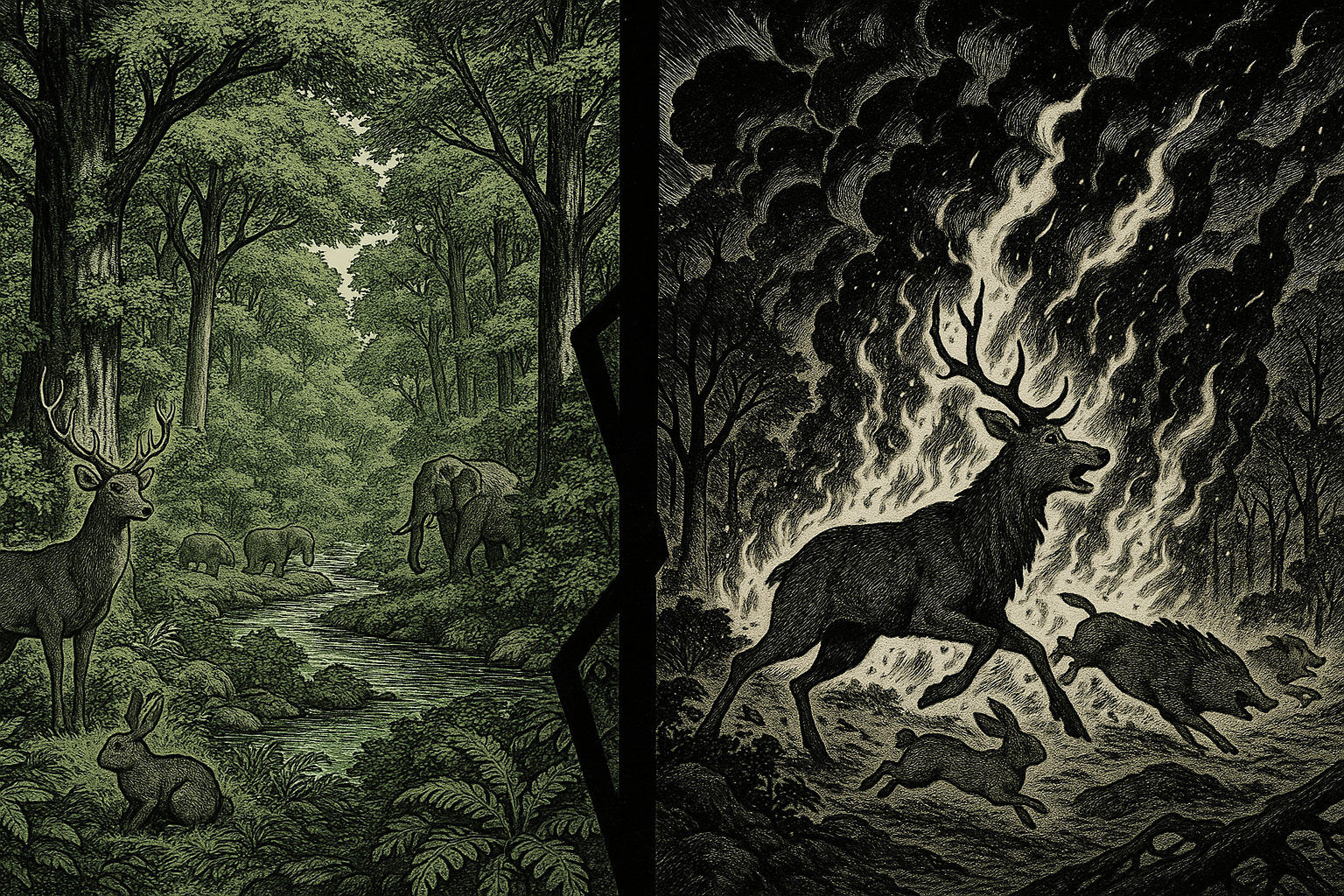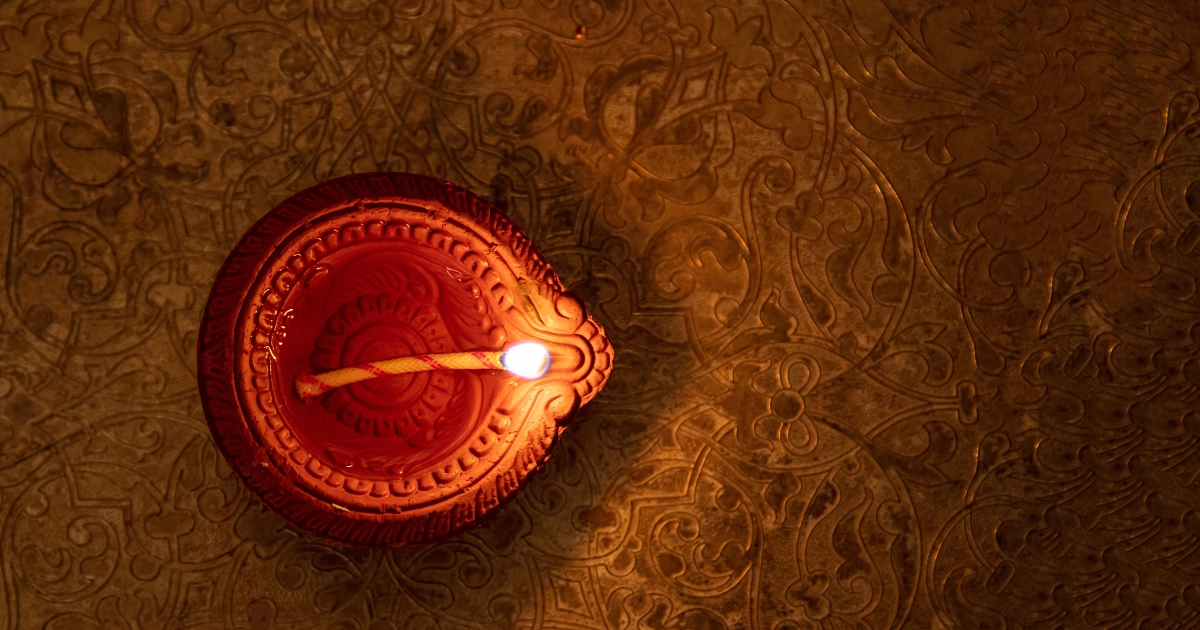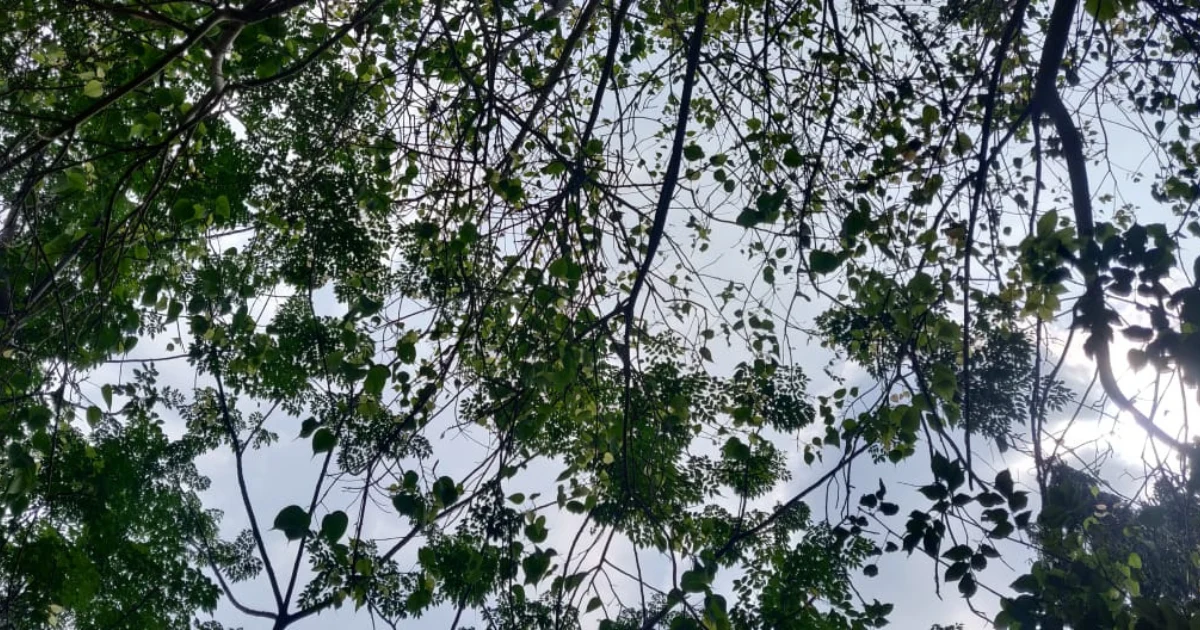This article was inspired by Ramachandra Guha's assertion that the Mahābhārata celebrated the destruction of forests, as referenced in Anurag Shukla's article **[Reclaiming the Forest - Against the Modernist Myth of Environmentalism in India](https://www.brhat.in/dhiti/reclaiming-forest-modernist-myth-of-environmentalism)**. Guha's provocative claim sparked a desire to delve deeper into not only the story of Khāṇḍava Daha (the burning of Khāṇḍava forest) but also to trace the origins of Khāṇḍava Vana itself.
Introduction
Khāṇḍava Vana stands as one of the most significant locations in Bhārat’s itihāsas, representing a complex intersection of divine politics, royal ambition, and cosmic balance. This sacred forest's story, spanning from its origins as a divine sanctuary to its ultimate destruction by Arjuna and Kṛṣṇa, offers profound insights into the cyclical nature of existence and the eternal tension between human civilization and the natural world.
Part I: The Sacred Origins and Transformation
The Divine Forest
In the beginning, Khāṇḍava was a great forest near the Himālayas, inhabited by divine hosts and pleasing to humans, gandharvas, yakṣas, and ṛṣis. This sacred woodland was home to divine trees, celestial flora, precious gems, supernatural medicines, various mythical creatures, including nāgas (serpents), ascetics performing penance, and gandharvas and other celestial beings.
King Sudarśana's Ambition
The forest's transformation began with King Sudarśana of the Soma dynasty, described as a great soul of immense strength, handsome appearance, and great valor. Driven by ambitious plans, this king cleared the vast sacred forest, driving away lions, tigers, and even ascetics to establish the magnificent city of Khaṇḍavi.
The Magnificent City of Khaṇḍavi
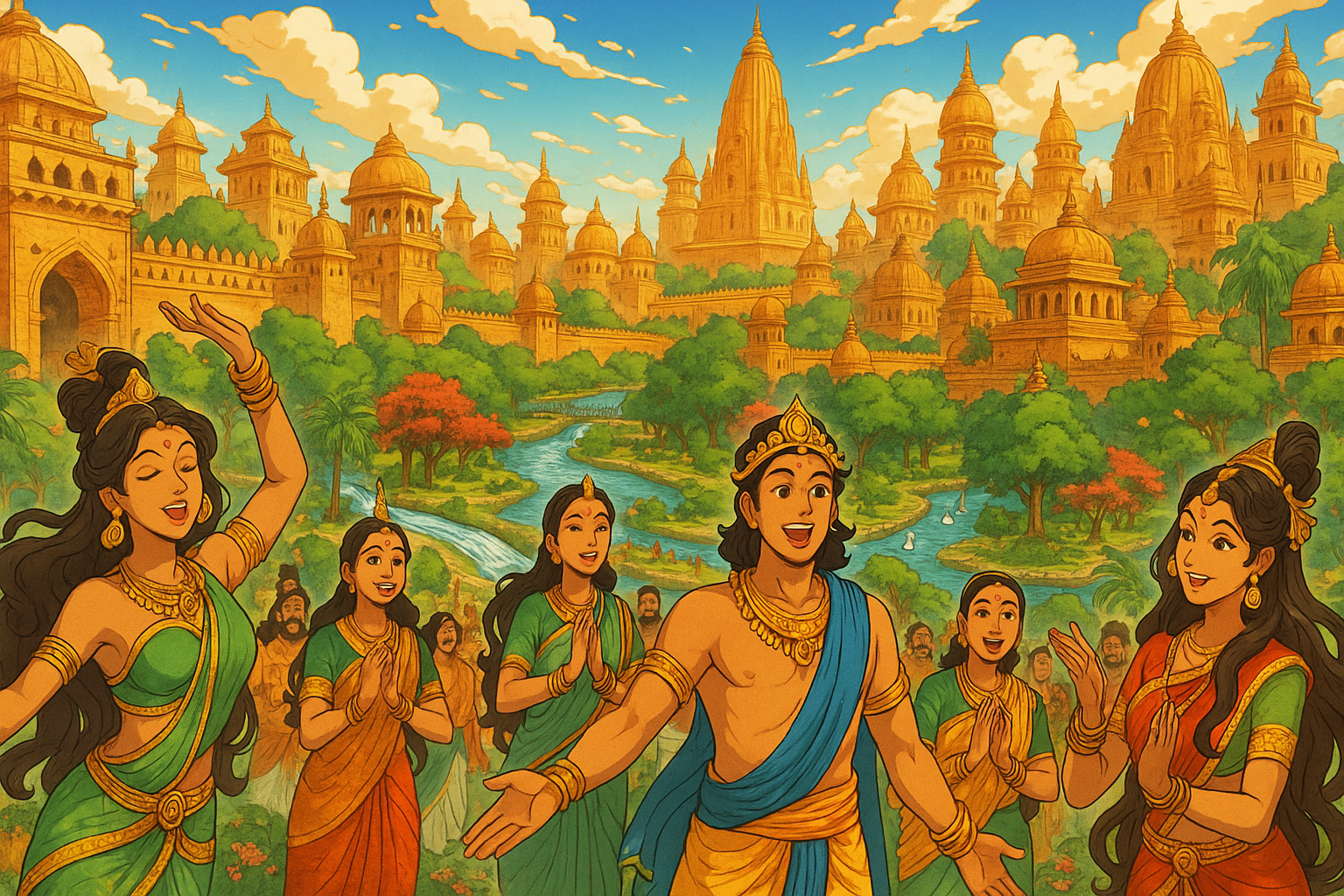
King Sudarśana created a truly spectacular urban marvel:
- Dimensions: Thirty yojanās wide and one hundred yojanās long
- Architecture: High walls, towers reaching the clouds, and grand gateways
- Water Features: Deep, long moats and numerous lakes, with the sacred Ganga river diverted from Kanakhala to flow through the city
- Gardens: Filled with groves and groups of celestial nymphs (apsaras)
- Population: The finest people who constantly celebrated festivals
The king's ambitions extended beyond urban planning. After conquering various rulers and amassing great wealth, he created treasure heaps of gems in the city's center. Through conquest of gods, demons, and gandharvas in battle, he planted divine trees, divine gems, and divine medicines throughout Khaṇḍavi along with his ministers.
Divine Retribution
Sudarśana's appropriation of divine property and harsh treatment of gods and humans eventually provoked consequences. Indra, unable to tolerate these transgressions, allied with King Vijaya of Vārāṇasī, a heroic ruler whom he appointed as minister and strategically positioned.
The ensuing battle between Vijaya and Sudarśana was comparable to the legendary conflict between Vṛtra and Indra. Ultimately, Sudarśana was struck down by Vijaya's mace, and his army fled in terror.
The Restoration
Upon entering the conquered city, King Vijaya was amazed by the sight—mountain-like heaps of gold and gems, lotus-filled lakes with swans, magnificent white palaces resembling Mount Kailāśa, and elephants stationed at every house. The splendor was so great that Vijaya thought he was witnessing Amarāvatī brought down to earth.
Indra then appeared and explained the forest's divine significance, revealing how Sudarśana had forcibly cleared the sacred woodland and expelled all divine beings. The gods requested Vijaya to restore the area to its original forest state, promising it would become a place where he could sport secretly with Takṣaka (the serpent king), and serve as a realm for ṛṣis, yakṣas, and kiṃnaras.
King Vijaya agreed out of respect for Indra. The treasures were transported to Vārāṇasī, divine property was returned to its rightful owners, and the thirty-yojanā-wide, hundred-yojanā-long city became a forest again. With Indra's approval, Takṣaka and his followers lived there, making it a sanctuary where gods, gandharvas, and groups of apsaras would come to play.
Part II: The Path to Destruction
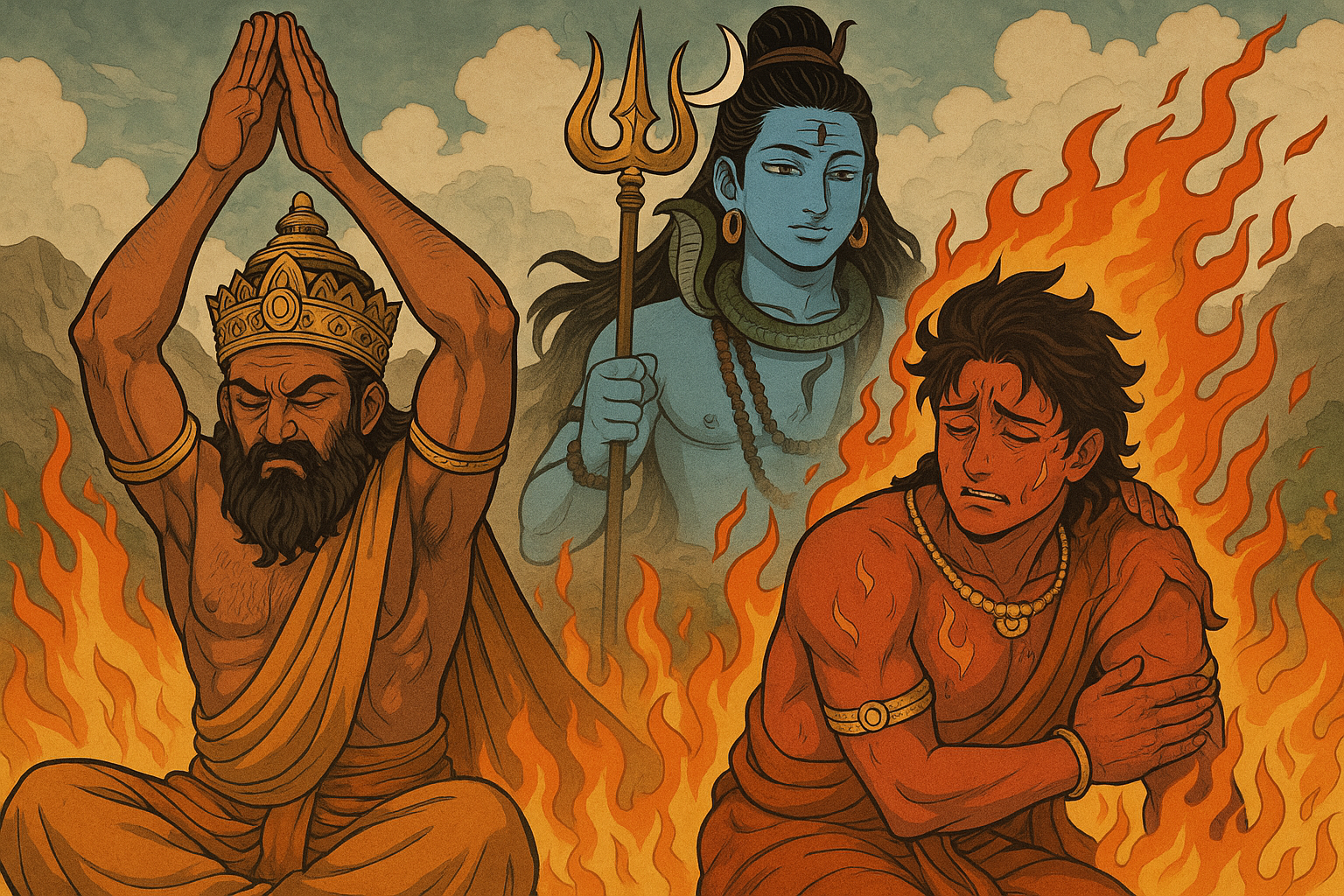
King Śvetaki's Religious Fervor
The events leading to Khāṇḍava's burning began with King Śvetaki, a ruler as powerful as the king of gods, known for his generosity and wisdom. His devotion to religious ceremonies was so intense that he performed continuous sacrifices for years.
During these prolonged ceremonies, ṛtviks had to pour clarified butter (ghee) into the sacred fire continuously. The constant smoke damaged their eyes so severely that they eventually refused to help anymore. When Śvetaki tried to find new ṛtviks for a planned hundred-year sacrifice, they also declined, leading to frustration on both sides.
The Divine Solution
Frustrated by the ṛtviks' refusal, King Śvetaki went to Mount Kailāśa and began intense meditation to worship Lord Śiva. For six months, he stood perfectly still with raised arms, eating only fruits and roots once every twelve to sixteen hours.
Impressed by this dedication, Lord Śiva appeared and agreed to help, but with a condition: the king must pour clarified butter into the fire continuously for twelve years while living like a monk. Śvetaki agreed and fulfilled this demanding requirement.
After twelve years, Śiva directed the ṛṣi Durvasa (who was part of Śiva himself) to perform the grand sacrifice, which became a tremendous success.
Agni's Illness
During Śvetaki's twelve-year sacrifice, Agni (the fire god) had to consume clarified butter continuously for all those years. Just as eating excessive, rich food makes one sick, Agni too became ill from this prolonged consumption. He lost his bright color, became weak, and felt nauseous.
Seeking relief, Agni approached Lord Brahma, explaining his condition and requesting help for his ailment.
The Prescribed Cure
Brahma provided a solution: There is a forest called Khāṇḍava that's full of creatures who are enemies of the gods. You burned it once before at the gods' request, but it has grown back. Go burn that forest and consume the fat of those creatures - that will cure your indigestion and restore your health.
Notably, Brahma described Khāṇḍava as आलयं देवशत्रूणां सघोरं खाण्डवं वनम् (an abode for demonic forces), indicating that the restored forest had become home to entities hostile to divine order.
Part III: The Great Burning
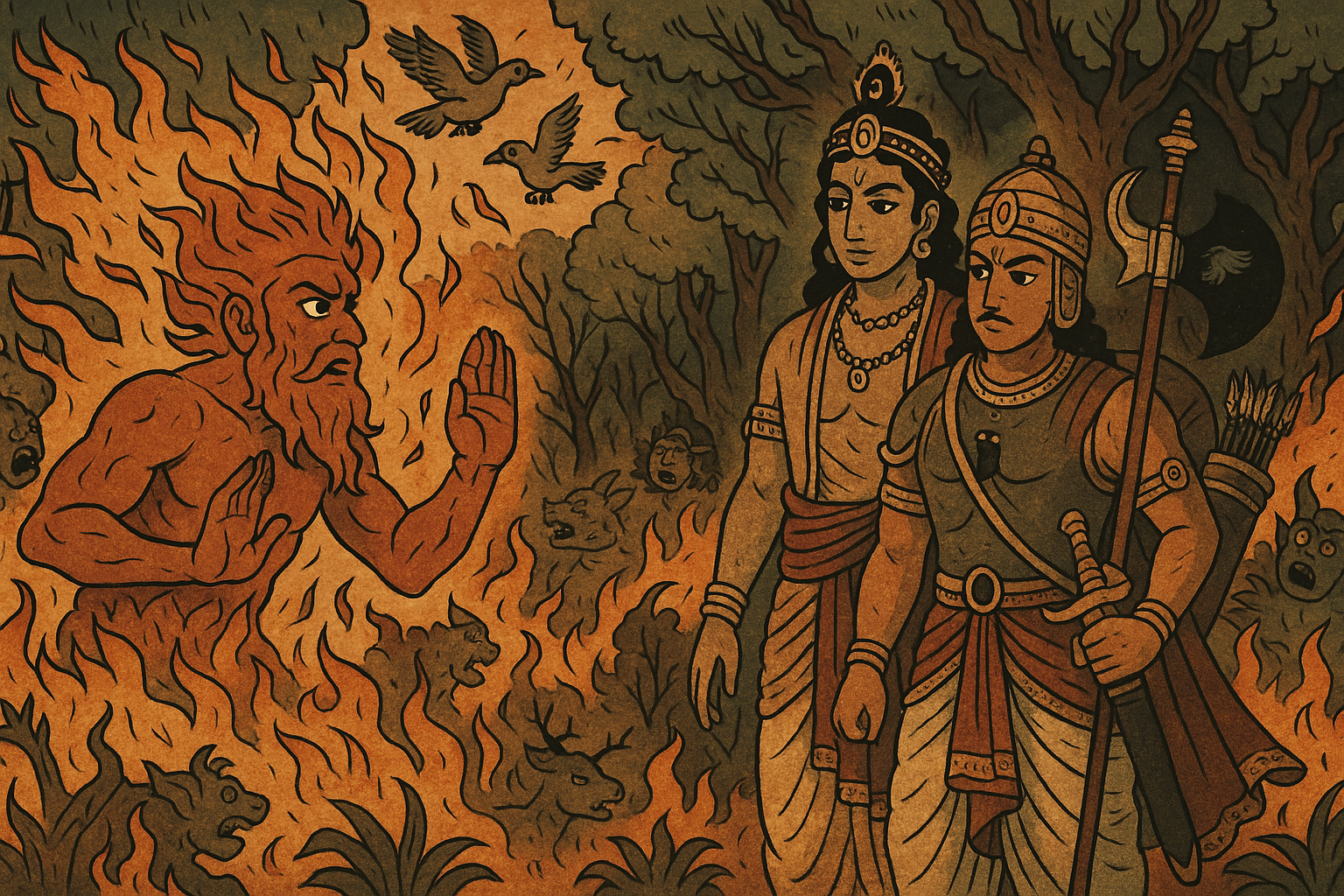
Agni's Dilemma
Armed with Brahma's prescription, Agni rushed to Khāṇḍava forest with great energy. However, he faced a significant obstacle: Indra's protection of the forest. The king of gods was shielding the woodland in the interest of protecting his friend Takṣaka and his family, preventing the natural cycle of periodic fires.
The Divine Request
In the twenty-eighth yuga of the Dvāpara age's end, Agni approached Arjuna in the form of a brāhmaṇa, seeking alms. When Arjuna agreed to give whatever was requested, Agni revealed his true form and explained his predicament.
The fire god needed to burn the entire Khāṇḍava forest—complete with its birds, animals, and demons—to cure his ailment. Due to Indra's opposition, Agni required Arjuna's assistance to accomplish this task.
The Great Battle
Arjuna, protected by Kṛṣṇa (Vāsudeva's son), agreed to help. As a reward for his service, the pleased Agni bestowed upon Arjuna several divine weapons and items:
- The Gāṇḍīva bow, created by Varuna
- Two inexhaustible quivers
- Four silver-colored horses
- A great banner with Hanuman's emblem
- A sharp three-pointed sword named Triśikha
With the wind god Vāyu's assistance, Agni burst into flames and began burning the entire forest. The creatures living there desperately tried to extinguish the fire, but Agni was determined to cure himself by consuming the forest.
The Survivors
Despite the comprehensive destruction, six creatures were allowed to survive:
- Asvasena (Son of Takṣaka)
- Māyā-asura (who would later create Indraprastha)
- Four birds
These survivors were considered not to be demonic in nature and therefore were spared from the conflagration.
Arjuna and Kṛṣṇa ensured that no other creature was left alive, completing the thorough cleansing that Brahma had prescribed.
Deeper Significance and Symbolism
Cosmic Balance
The Khāṇḍava narrative serves multiple profound purposes:
- Natural Cycles: Indra's protection preventing periodic fires represents interference with natural ecological cycles, while the eventual burning restores balance.
- Divine Justice: The story demonstrates how cosmic order is maintained, with different aspects of divinity (Brahma prescribing, Agni executing, Arjuna facilitating) working together.
- Heroic Validation: For Arjuna, the burning established his credentials as a great warrior blessed by the gods and capable of serving divine purposes.
- Environmental Symbolism: The cycle of forest-to-city-to-forest-to-destruction reflects ancient Indian understanding of the relationship between civilization, nature, and cosmic order.
Ecological Insights
The story contains remarkable ecological wisdom, acknowledging that:
- Forests require periodic fires for regeneration
- Preventing natural cycles can lead to problems
- The balance between protection and destruction is delicate
- Human intervention in natural processes has consequences
Conclusion
The complete story of Khāṇḍava Vana presents a rich, multi-layered narrative that goes far beyond a simple tale of forest burning. It encompasses themes of royal ambition, divine intervention, cosmic justice, and the complex relationship between human civilization and the natural world.
From its origins as a divine sanctuary, through its transformation into a magnificent city and restoration as a sacred woodland, to its final destruction for cosmic balance, Khāṇḍava Forest embodies the cyclical nature of existence and the ultimate supremacy of divine will over temporal ambitions.
The narrative's environmental consciousness, expressed through Janamejaya's concern for the forest filled with various living creatures, demonstrates that ancient Indian literature was deeply aware of ecological implications. The story ultimately suggests that while destruction may seem harsh, it sometimes serves a greater cosmic purpose—restoring natural cycles, eliminating harmful elements, and preparing the ground for new growth.
In our contemporary world, grappling with environmental challenges and the balance between development and conservation, the ancient wisdom embedded in the Khāṇḍava Vana story offers timeless insights into the delicate relationship between human progress, natural systems, and the sacred dimensions of our world.
